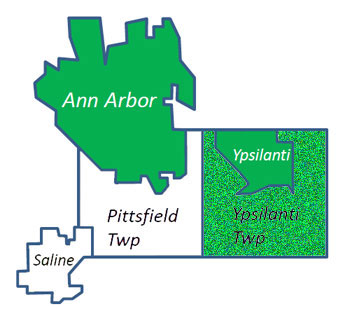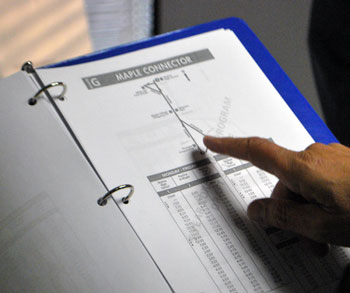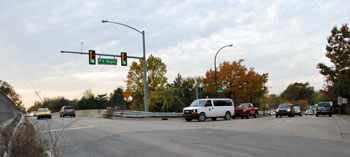Council Agenda: Transportation Governance
On the Ann Arbor city council’s Nov. 18, 2013 agenda is an item that first appeared on Oct. 21 – approval of a change to the governance of the Ann Arbor Area Transportation Authority. How would the AAATA’s governance change? And why did the Ann Arbor city council delay its vote?

Ypsilanti Township would become a member of the AAATA, if the Ann Arbor city council approves a change to the AAATA’s articles of incorporation at its Nov. 18, 2013 meeting.
The governance change would grant a request from Ypsilanti Township to be admitted as a member of the authority, joining the cities of Ann Arbor and Ypsilanti. The city of Ypsilanti requested membership in the AAATA just this summer, and that request was granted.
Some of the recent community conversation about the topic has included the idea that the governance changes were long overdue. That’s based on the fact that some transportation service to the two Ypsilanti jurisdictions – the city and the township – has been provided by the AAATA through year-to-year purchase of service agreements (POSAs) since at least the early 1980s.
As a result of action earlier this summer, the AAATA board has already expanded from seven to nine members, with one of the additional seats appointed by the city of Ypsilanti. The now-pending governance change, to add Ypsilanti Township as a member, would bring the total number of board seats to 10. [Amendment 3 of the AAATA articles of incorporation]
But the Ypsilanti jurisdictions asked for membership in the AAATA not just because they wanted a seat at the table. They also want to use that membership to help generate additional revenue in the AAATA geographic area – to pay for additional transportation services in all three jurisdictions. Those additional services are described in a five-year service improvement plan the AAATA has developed. The additional services – which include extended hours of operation, greater frequency, and some newly configured routes – were the topic of a series of 13 public meetings that were scheduled from Oct. 17 through Nov. 14.
For the city of Ann Arbor, the five-year plan would mean 33% more service, according to the AAATA. It’s the additional services, and the revenue needed to pay for them, that gave some Ann Arbor city councilmembers pause on Oct. 21, 2013, when the item first appeared on the agenda.
This article reviews some additional context, including the taxing powers of the AAATA, the issue of equity among jurisdictions, the AAATA’s performance as a transit authority, and a couple of vignettes from the series of public meetings held over the last month by the AAATA.
Ann Arbor City Council: Final Say
The Ypsilanti Township board voted on Sept. 9, 2013 to request membership in the AAATA. Two weeks later, at its Sept. 26, 2013 meeting, the AAATA board approved the amended articles of incorporation to add Ypsilanti Township as a member of the authority. And on Oct. 15, 2013 the Ypsilanti city council approved the change to the articles of incorporation.
That leaves action by the Ann Arbor city council as the final step in admitting Ypsilanti Township as a member.
One document that some Ann Arbor city councilmembers wanted to see on Oct. 21 was a memorandum of understanding between the AAATA and Ypsilanti Township that would ensure payment for transportation services. The fact that a draft document was not available at that time was one reason some councilmembers were inclined to delay approval. That document is now available. [.pdf of draft YT-AAATA MOU]
The Ann Arbor/Ypsilanti Regional Chamber of Commerce has weighed in, urging the Ann Arbor city council to approve the amendment to the articles of incorporation. [.pdf of A2Y Chamber support letter]
Who Levies What Taxes?
Through their membership in the AAATA, the Ypsilanti jurisdictions would have the same ability as the city of Ann Arbor tax themselves – so they can pay for the additional transportation services in their geographic area. Specifically, AAATA membership would allow the Ypsilanti jurisdictions to join the city of Ann Arbor in taking advantage of the authority’s ability – under Act 55 of 1963 – to ask voters to approve a new transportation tax. Any request would need majority approval of voters across the entire geographic area of the member jurisdictions.
The power to request and then levy a voter-approved tax is one the AAATA has never used before. Readers might be familiar with two different existing transportation taxes – one paid by Ann Arbor property owners (2.053 mills) and another paid by city of Ypsilanti property owners (0.987 mills). Those existing taxes are not levied by the AAATA, but rather by the respective cities. The proceeds of those taxes are passed through to the AAATA. The city of Ypsilanti does not have the option of increasing the amount of its own transportation tax – because Ypsilanti is already at the state constitutional limit for taxes levied by a city, which is 20 mills. But an AAATA tax would not count against that constitutional limit.
The five-year service improvement plan that the AAATA has developed would need an estimated 0.7 additional mills levied across the geographic area of the authority. One mill is $1 per $1,000 of taxable value. So for a $200,000 house, with taxable value of $100,000, a 0.7 mill tax would translate into $70 a year. For an Ann Arbor taxpayer who owned that $200,000 house, that would translate into about $270 a year total in transportation taxes.
One option that’s been floated to pay for transportation improvements within the city of Ann Arbor – using just the existing Ann Arbor tax – would be to ask Ann Arbor voters to approve an override of the Headlee Amendment. Headlee has reduced the amount of the levy from its voter-approved level of 2.5 mills to the current 2.053 mills. So approval of a Headlee override would result in about 0.5 mill more revenue to fund transportation services within the city of Ann Arbor.
Translating millage rates into total dollars, Ann Arbor’s city transportation tax currently generates $9,565,000 annually, according to AAATA. A 0.7 mill additional tax would generate $3,230,007 in additional revenue in the city of Ann Arbor for a total Ann Arbor local contribution of more than $12.7 million. According to AAATA, Ypsilanti’s dedicated millage generates $274,000, which is less than its POSA agreement called for last year. The 0.7 mill tax would generate around $189,785 in additional revenue in the city of Ypsilanti, for a total contribution in the city of Ypsilanti of around $464,000. Ypsilanti Township currently pays $329,294 annually for transportation services under its POSA agreement. If a 0.7 mill tax were approved, that would generate around $707,969 in the township. Based on the amount of expanded services that the township would receive, the township contribution would be defined as just that $707,969.
Equity
The current, more localized expansion of the AAATA contrasts with a now demised effort in 2012 to incorporate all of Washtenaw County into a single countywide transportation authority. When the Ann Arbor city council withdrew Ann Arbor’s participation in that effort, at its Nov. 8, 2012 meeting, it gave encouraged the AAATA to “to continue to discuss regional transportation options among Ann Arbor, Ypsilanti, Ypsilanti Township, Ann Arbor Township, Pittsfield Township, and Scio Township, leading to a better understanding and process for improving local transit options…”
Over the course of the last year, the AAATA held a series of meetings with officials from those municipalities, a group that came to be called the “urban core” communities.
One outcome of those conversations was an interest in membership in the AAATA on the part of the two Ypsilanti jurisdictions. The city of Ann Arbor (pop. ~116,000), the city of Ypsilanti (pop. ~19,500) and Ypsilanti Township (~53,000) make up a bit more than half the population of Washtenaw County (pop. ~351,000).
The differences in financial contribution by each of the jurisdictions receiving transportation service from the AAATA was a topic that dates to the countywide effort. It’s also been a topic of the urban core conversations about equity: Is the amount of service provided commensurate with the financial contribution?
Various methodologies can be applied to the challenge of allocating costs. At a meeting held at the Saline city hall on April 25, 2013, AAATA staff illustrated how equity stacked up for some of those methodologies. According to AAATA staff, that equity analysis has not been re-run since then to reflect the latest refinements in the service plan, but the basic conclusions weren’t expected to be dramatically different. The chart below is by The Chronicle, using AAATA numbers from earlier this year. The analysis assumes a uniform millage across the five jurisdictions in the chart.

Interpreting the chart. The left axis is a percentage. Zero means that the ratio of benefit to revenue is 1:1. A positive bar means that a jurisdiction gets more benefit (services with greater cost) than the jurisdiction would contribute under a uniform millage. A negative bar means a jurisdiction gets less benefit (services costing less) than the contribution of that jurisdiction in a uniform millage.
The method used to calculate the cost of POSA agreements is by service hours.
Performance
One criticism of the AAATA that has been a part of recent community conversation is the contention that administrative overhead costs are too high – and that additional operational efficiency could and should be achieved before expanding service. At the Nov. 14 community engagement meeting, held in Ypsilanti at SPARK East on Michigan Ave., part of the presentation included a slide that in part confirmed the idea that AAATA’s operating expenses are per hour higher than average – 18% higher when compared to peer transportation authorities. But that same slide included analysis showing that the AAATA’s operating expenses per passenger were 17% lower.
AAATA’s choice of the peer communities in this analysis was based on recommendations from the Transit Cooperative Research Program (TCRP) to use the Florida Transit Information System (FTIS) as an analysis tool for National Transit Database figures. Those peer communities are: Peoria, IL; Lexington, KY; Moline, IL; Lansing, MI; Syracuse, NY; Savannah, GA; Champaign-Urbana, IL; Roanoke, VA; Concord, CA; Erie, PA; Kalamazoo, MI; Harrisburg, PA; Fort Wayne, IN; Rockford, IL; Shreveport, LA; Hartford, CT; Fort Collins, CO; Scranton, PA; Gainesville, FL; and South Bend, IN.
Public Meetings
During the month-long delay by the Ann Arbor city council in voting on Ypsilanti Township’s membership, the AAATA has continued a series of 13 meetings – designed to introduce residents to a five-year service improvement plan – which would require additional funding.

At the Oct. 28, 2013 public meeting on service plan improvements, held at AAATA headquarters, Jack Eaton points at Route G, a proposed new route. He suggested that it continue from Stadium & Pauline on to Pioneer High School, before looping back to the north, which would complete a connection between two high schools – Skyline and Pioneer.
The series of meetings began on Oct. 17 before the council’s Oct. 21 decision to postpone. The last of those meetings took place in Ypsilanti on Nov. 14.
At the council’s Oct. 21 meeting, Stephen Kunselman (Ward 3) provided one of the eight votes for postponement, so he was keen to assure Ypsilanti Township officials – who were present at the meeting – that he was still supportive of their membership in the AAATA.
He indicated at the council’s Oct. 21 session that he would be attending some of the public meetings to show his support. Responding to an emailed query, Kunselman wrote to The Chronicle that he’d attended three of the meetings – on Oct. 29 at the Michigan League, on Nov. 6 at Tappan Middle School and on Nov. 12 at the Malletts Creek branch of the Ann Arbor District Library.
The first meeting (which is available through CTN’s video on demand) was held just before the AAATA’s regular board meeting on Oct. 17. Details of the service improvements, including maps and scheduling, are available on the AAATA’s website.
The conversation at the public meetings ranged from policy concerns to extremely practical issues.
On the policy side, for example, the AAATA staff heard from a taxicab driver at the first public meeting complaining that the cheap price of the AAATA’s new AirRide service to the Detroit Metro airport diminished his ability to earn a livelihood driving a cab.
As an example of the practical side, a question was raised at the Oct. 18 meeting about the ability of a bus to easily make the right-hand turn from South Maple onto Scio Church, which would be required by the new Route E. The turn is less than 90 degrees.
That pre-election question came from former bus driver Jack Eaton, who was elected to represent Ward 4 on the city council on Nov. 5. [Eaton's bus driving career included 10-years with Kalamazoo Metro Transit from 1974 through 1984. Eaton now earns his livelihood as a labor attorney.]
Responding to Eaton, AAATA manager of service development Chris White allowed that when he’d presented the new route configurations to AAATA drivers, that was the one concern they’d raised. White felt that by using part of the neighboring lane, that turn could be navigated.
Eaton will be attending his first meeting as a sitting councilmember on Nov. 18, with the Ypsilanti Township membership on the agenda.
The Chronicle could not survive without regular voluntary subscriptions to support our coverage of public bodies like the Ann Arbor Area Transportation Authority. Click this link for details: Subscribe to The Chronicle. And if you’re already on board The Chronicle bus, please encourage your friends, neighbors and colleagues to help support The Chronicle, too!








Thank you for highlighting this issue. I’d like to point out that the chart based on the April figures includes the City of Saline and Pittsfield Township,who have declined to join AAATA at this time and who will thus not be participating in the millage. This is likely to alter percentages as shown.
The chart is also based only on the NEW tax, not on total tax exposure. But both Ann Arbor and the City of Ypsilanti have a current millage tax, and their total tax contribution for the overall system will be much greater than that of Ypsilanti Township, which brings only the hypothetical new millage to the table.
Finally, it has been confirmed (at one of those meetings) that costs of service are based on average (the whole system) expenses per service hour. But new routes, especially those to more rural areas and requiring new bus purchases, are likely to cost more than the average.
Vivienne, why would new routes cost more than existing routes? The bus purchases are a capital expense, and the cost per service hour is an operating expense, and it’s best to not conflate the two. (After all, existing routes have buses that are depreciating and you’d want to take that into account in any overall calculation.)
Rural routes, if anything, will cost less per operating mile, because the buses will be going faster on those streets. They are probably more per passenger because there are fewer passengers on the bus.
Fair point, I don’t have all the information. But my point is still valid that they are using an average expense figure. Looking at the Report to the Treasurer, depreciation is figured in as part of the expense overall. I’m guessing that the depreciation curve is steeper for new buses, but I don’t know.
Demand response will be included as part of any new service, wherever new fixed route buses go. That surely is a variable expense for more rural areas.